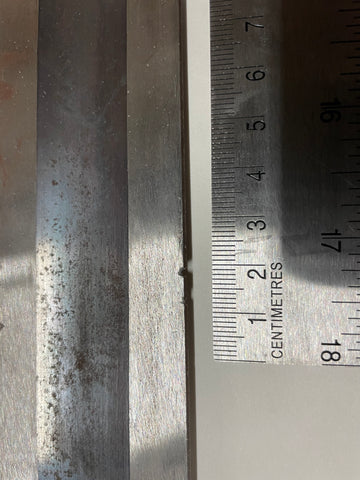Today we take a look at how to resharpen a modern sword in a manner consistent with the hints original swords give us about this task. Using one of the swords from our Edge on Edge Contact testing video, Craig walks us through how a medieval cutler might have taken on this task, and demonstrates how we do it today.

A close up of the damaged section of the blade with a ruler for scale.
In order to restore the nicked sword to soundness the blade must be reprofiled, in essence the edge of the blade around the nick needs to be ground back to the deepest point of the nick. One characteristic of a sword that has been damaged and then reprofiled is that the edge will no longer be straight, but will instead feature a swooping concavity where blade material was ground back. This is important to do as a nick is a weak point in a blade that will eventually cause the blade to fail. As we will show in a post next week, many historical swords feature evidence of reprofiling just like this.

Nathan Clough, Ph.D. is Vice President of Arms and Armor and a member of the governing board of The Oakeshott Institute. He is a historical martial artist and a former university professor of cultural geography. He has given presentations on historical arms at events including Longpoint and Combatcon, and presented scholarly papers at, among others, The International Congress on Medieval Studies.
Craig Johnson is the Production Manager of Arms and Armor and Secretary of The Oakeshott Institute. He has taught and published on the history of arms, armor and western martial arts for over 30 years. He has lectured at several schools and Universities, WMAW, HEMAC, 4W, and ICMS at Kalamazoo. His experiences include iron smelting, jousting, theatrical combat instruction and choreography, historical research, European martial arts and crafting weapons and armor since 1985
